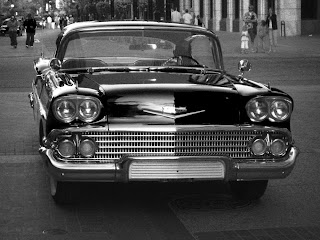 Week 11
Week 11I enjoyed doing this one - looks like an old photograph doesn't it? This Chevy was stopped in the middle of the road on Stephens Avenue in Calgary just down from where we were about to go in and eat. I didn't know why he was stopped where he was but I liked the head on view so I walked down to where he was, stepped out in the road, and quickly composed and shot the picture.
But I am getting ahead of myself. The idea here is to try a digital point and shoot instead of your fancy SLR. I used a digital point and shoot for years before I got my first digital SLR and used to carry mine everywhere I went - that is the beauty of them. They are handy and they aren't near as conspicuous as a Nikon D3....
Of course the downsides are that they have shutter lag, don't do as well in low light (look at the noise in this photo), you can't swap lenses, most of them don't have as much artistic control, overall quality is lower at high enlargement, etc. Oh yeah though, I left out an important plus, they are way cheaper. Overall, in good light with subjects that aren't moving too much they do just fine and they also can be enlarged up to 5x7 and even 8x10 for prints.
Now, back to the picture. This guy wasn't moving because his car was broke down. I only figured that out because a wrecker pulled up and hauled him away. Nice car though....
The camera is a Canon IXY Digital 70 and it is a couple of years old now. I have owned a couple of Canon IXYs and they were all good - just don't drop them, especially with the lens extended. The camera was set on automatic and I don't know what the ISO speed or 35mm lens equivalent is. I know I composed by zooming in somewhat.
The light is late afternoon coming over my shoulder straight at the car and there are some fairly strong reflections as a result. The EXIF data says the camera chose f/4.9 and 1/125 of a second. The hood of the car is sharp, the background soft and grainy from the relatively low light. I like the composition and didn't crop it at all.
Post processing consisted of increasing contrast and applying a B&W adjustment layer in Photoshop with the infrared option selected. I usually use the B&W layer these day for B&W instead of other techniques and try the different filter options in it to get ideas before tweaking further. In this case, the infrared really darkens the car because it was cherry apple red to begin with (click here for the original photograph without any post). I put some vignette around it and that was that.
Idea based on Pocket Power, pages 86-87 in the book 50 Photo Projects, by Lee Frost



